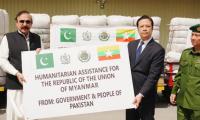LAHORE: Operating with an annual budget of US$18.2 billion, the Turkish Armed Forces collectively rank as the second largest standing military force in Nato, after the US Armed Forces, with an estimated strength of 639,551 military, civilian and paramilitary personnel in 2015.
According to the American Central Intelligence Agency’s World Fact Book 2016, the Turkish military expenditures had rested at 2.29 per cent of country’s GDP in 2015, slightly down from the 2014 estimates of 2.36 per cent of national GDP.
The 2016 CIA World Fact Book states: “The ruling Justice and Development Party (AKP) has actively pursued the goal of asserting civilian control over the military since first taking power in 2002.The Turkish Armed Forces (TSK)’s role in internal security has been significantly reduced. The TSK leadership continues to be an influential institution within Turkey, but plays a much smaller role in politics. The Turkish military remains focused on the threats emanating from the Syrian civil war, Russia's actions in Ukraine, and the Kurdistan Workers' Party (PKK) insurgency.”
It adds: “The primary domestic threats are listed as fundamentalism (with the definition in some dispute with the civilian government), separatism (Kurdish discontent), and the extreme left wing; Ankara strongly opposed establishment of an autonomous Kurdish region in Iraq; an overhaul of the Turkish Land Forces Command (TLFC) taking place under the "Force 2014" programme is to produce 20-30 per cent smaller, more highly trained forces characterised by greater mobility and firepower and capable of joint and combined operations.”
The 2016 CIA World Fact Book maintains: “The Turkish Land Forces Command (TLFC) has taken on increasing international peacekeeping responsibilities including in Afghanistan; the Turkish Navy is a regional naval power that wants to develop the capability to project power beyond Turkey's coastal waters; the Navy is heavily involved in Nato, multinational, and UN operations; its roles include control of territorial waters and security for sea lines of communications. The Turkish Air Force had adopted an "Aerospace and Missile Defense Concept" in 2002 and has initiated project work on an integrated missile defense system. The Air Force priorities include attaining a modern deployable, survivable and sustainable force structure, and establishing a sustainable command and control system.”
The Turkish military, by the way, has a record of intervening in politics, removing elected governments four times in the past. According to 2016 figures from the International Institute for Strategic Studies (IISS), the country has 402,000 soldiers (77,000 professionals and NCOs/325,000 conscripts) in its land force, 48,600 in the navy (14,100/34,500) and 60,000 in the air force.
Added to this are more than 100,000 members of the gendarmerie, or paramilitary police, who fall under the command of the Ministry of the Interior rather than National Defence, according to figures from 2015.
Turkey also has a total of nearly 400,000 reservists in the three services. The navy has 13 submarines, 18 frigates and six corvettes, while the air force can currently draw on over 200 F-16s, the second-biggest number after the United States.
Dubbing the Turkish Army as one of the best-trained in the world, the most recent July 16, 2016 edition of the “Manila Times” has observed: “The Turkish army, which comprises 510,600 troops, down from around 800,000 in 1985, is considered one of the best trained in the world. Over the past year it has been focusing most of its energies on fighting separatists from the Kurdistan Workers’ Party (PKK) in the south-east and carrying out air strikes against PKK bases across the border in northern Iraq. Hundreds of Turkish military personnel have been killed in the fighting which restarted after the collapse of a two-and-a-half-year truce in mid-2015.”







